Posts tagged games
Thoughts on Student Safety and Using OpenSim for Education
1OpenSim is making headway as a viable alternative to Second Life. About 98% of the functionality of Second Life is present in OpenSim. The remaining 2% primarily deals with vehicle physics. Although it is still considered “alpha” software, OpenSim hosting is sold, and teachers, students, and businesses are taking advantage. The alpha status reflects more on the rapidly changing nature of the virtual world market, than the stability of the software itself. Microsoft and IBM have some backing in it. Intel operates its ScienceSim experiments with OpenSim, and has made headway in providing models for ubiquitous shareable content and massive user connections.
There are definitely some measures being taken to address educators’ needs. The Jokaydia and 3rd Rock Grids have been around for several years, and they are largely education-oriented. Last year, Firesabre launched its own Starlight Grid, which provides private hosting for educators. And Kitely is starting to establish itself as the premiere third-party choice for educators, and provides the option for making user-created regions private. However, as hypergridding becomes more stable and common, this can be the vehicle to unite different grids into a single education-related hypergrid. The common “education hypergrid” should blend the most relevant content for students and teachers into a singularly accessible virtual space. There should never be any reason for a teacher or student to log out of their viewer and log back into another grid with a whole new avatar. But we need to think about how to make such a hypergrid suitable for students, especially K-12 since there’s often a litany of additional laws and policies governing online interactions and access for them.
A few thoughts and ideas come to mind:
- It is more productive to include students rather than solely use teachers to create content. Many teachers already do this, since with their often beyond-full-time jobs they simply don’t have the time to both learn the skills needed for building in a virtual world, and actually construct the content alone. We should use the skills of the young tech-savvy generation, and develop constructionist class projects that appeal to our students.
- Activities should directly tie in with the curriculum. This is rather obvious, but it would be useful if virtual world activities were tagged with the relevant standards and/or objectives they address. This way, others in the same state, province, or country can find relevant material, without having to wonder if it actually addresses the necessary learning content or is just another topical sim.
- To address safety issues, different approaches have been taken. I mentioned above how FireSabre and Kitely provide private regions. For educators, they don’t want inappropriate content to drift in, or outside trolls to visit the region and cause havoc while students are using it. While securing a sim for exclusive private access is well-intentioned, they miss out on the community-produced educational content. Whether this is on Second Life, OSGrid, or any other virtual world system, a significant strength of the virtual world is in its shared content. We should avoid having to recreate the wheel each time.
- One solution could be to script a session monitor. Those who wish to join the education hypergrid can be required to place a script inside each region which connects to a server and monitors participants. Teachers who wish to use a particular region (or group of regions) for learning but are worried about others coming in and disrupting the class can reserve a session, and either enter their students’ avatar names, or have the students sign up themselves. The script would monitor anyone entering or currently in the region and kick out anyone not registered for the session. A publicly viewable calendar in the regions and on the web would let others know what time slots are open.
- We need to provide a venue for coordinating with educators and organizations who are considering investing actual time or money in the development of a sim. If similar goals and objectives can be identified, pooling resources together may help alleviate the burden for all parties involved.
-
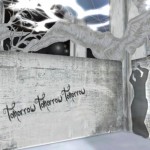
Regions such as the "Foul Whisperings, Strange Matters" Macbeth sim in Second Life could be added to an educator-maintained whitelist so the viewer knows it's student-appropriate
One solution to the problem of inappropriate content and the ability to provide a safe gateway to Second Life for students 16+ may be to build a custom viewer that uses whitelists. Ideally based on Viewer 2/3 (e.g. Kokua and Firestorm are two viewers being developed off this branch), it would access a server-maintained whitelist of regions appropriate for students. Anything not on the whitelist would not be accessible from the viewer. This can cross over to OpenSim as well. Though some regions on different grids may be “education-appropriate” and suitable to be hyperlinked to, other regions may not be. A mechanism in the viewer could prevent teleporting to regions that aren’t specifically part of the education hypergrid. This doesn’t prevent the usage of other viewers from bypassing these client security measures, but it’s still one measure that could help, and may meet the security policies of many schools and districts. Another option is to implement a teleport-restricting module on the server side so it limits access to educational regions, but since OpenSim is still in alpha, requiring it be included in all upgrades may be inconducive, unless a separate fork of OpenSim is made (much like OSGrid or Diva Distro). - When appropriate, content should be Creative Commons-licensed. This isn’t entirely necessary, and I believe there is tremendous value in reinforcing the commercial OpenSim goods market. But any CC content could be provided as OARs and IARs (compressed archives of OpenSim content), so it can be installed on private servers. Direct links to OARs and IARs should be posted inside the regions themselves, when possible.
- We should create an open, zero-cost (for the end user) conference region. This can be accessed from anywhere in the hypergrid, and can be reserved for school events or professional development as needed.
Hopefully I’m not too far off base with some of these thoughts. I believe as we move forward it will become increasingly important to standardize how educational simulations are maintained so they can meet the policies and safety standards of most school systems.
This article was reprinted in Hypergrid Business.
A Theoretical Model for Virtual Worlds in Weber School District
0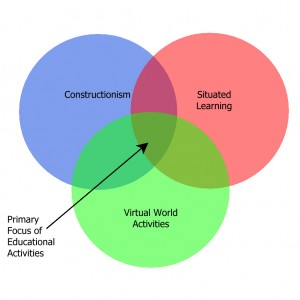 I’d like to implement virtual worlds in Weber School District. Hopefully, I’m in a position to actually steer things in this direction, and make it happen and get beneficial results. My concern with the implementation is that Second Life itself has a minimum age of 16. Great for high school kids, but it leaves out anyone younger. Plus there’s safety and security policies in place that make it complicated. However, if we used OpenSim or another third party, self-hosted virtual world solution, we could have complete control over the server, albeit at a loss of the rich content in Second Life. In essence, we’re starting from scratch.
I’d like to implement virtual worlds in Weber School District. Hopefully, I’m in a position to actually steer things in this direction, and make it happen and get beneficial results. My concern with the implementation is that Second Life itself has a minimum age of 16. Great for high school kids, but it leaves out anyone younger. Plus there’s safety and security policies in place that make it complicated. However, if we used OpenSim or another third party, self-hosted virtual world solution, we could have complete control over the server, albeit at a loss of the rich content in Second Life. In essence, we’re starting from scratch.
This is why we must adopt a constructionist approach when addressing virtual world instruction. Constructionism is a form of constructivism where artifact creation is the product of learning. The way I see it, students themselves should be the primary creators of the content and build the sims, under the direction of the teacher. Lessons should be designed that teach the intended content while the student is in the process of constructing, and the lessons should be designed to support a situated learning framework. Identifying an appropriate context for the learning, and focusing on collaborative activities is important.
When implementing constructionist activities in Second Life or OpenSim, it’s crucial that the teacher facilitates and provides consistent scaffolding support to the students, especially when there are varying skill levels. This takes constant observance of the activities, and at no time should a teacher stand on the sidelines, but be actively engaged in the process. With this type of activity, it is important that the instructor be continually and intimately aware of everything going on, to facilitate the experience. During the activity, the teacher should consistently provide help or suggestions that ensure a smooth and effective learning experience.
Identifying the types of activities that support the constructionist mode of learning inside the virtual world will enable us to find the right balance that fosters optimal learning opportunities. I certainly realize that there are many other ways to learn in a virtual world besides building content. But this is a necessary model for Weber School District, due to our existing infrastructure.
The learning activities that should be implemented, necessarily should adopt this “situated constructionist” approach. This way, especially with the forthcoming mesh abilities of Second Life and OpenSim, drafting students could import their buildings into Second Life. 3d animation students could import their characters and models. Programming students could learn the Linden Scripting Language and code the simulations. The virtual world implementation will be autonomous, and draw upon effective learning theories to guide its educational development.
Related articles
- Why Open Sim will Dominate Virtual Worlds in Education (coolcatteacher.blogspot.com)
- Reflections on Immersive Virtual Learning (weber.k12.ut.us)
- Teaching and Learning Options in the Virtual World (gridjumper.net)

Engaging Learners Through Video Game Principles
1In a TED Talk from 2010, Tom Chatfield describes seven aspects that lend to the creation of effective, engaging games. They can particularly be applied to how we learn in general. The video is shown below, and he starts describing the seven aspects around the 8:30 mark.
These ideas apply directly to how learning-oriented games can be designed, and to a large degree apply to the physical classroom environment as well. Chatfield’s list is as follows:
1. Experience bars measuring progress
Instead of assigning grades, some teachers have turned to an experience point system. This is a familiar aspect of games, and measures a student’s steady progression through tasks (or “quests”). This system can apply to traditional classroom learning as well, and a teacher could accomplish this by putting experience bars up on a board, or manage it with online student profiles. Experience points are great at measuring progress over time in a nuanced, quantified manner, perhaps moreso than a flat list of assignments on a student’s progress report can do.
2. Multiple long and short-term aims
Students should be allowed to participate and choose different types of quests. Different quests can lead to larger goals, but students should be allowed to guide their progress, and take ownership of what they choose to accomplish. With enough “subquests,” students feel as though they are continually progressing, and have a clear end in sight.
3. Reward for effort
This goes back to standard behaviorist principles. If desired behavior is rewarded, the behavior will be reinforced and more likely to be repeated. We shouldn’t punish students when they fail, but instead recognize their achievements as they learn. Games teach us that we should turn “failure” into “success not yet realized.”
4. Rapid, frequent, clear feedback
One of the advantages of games is that they allow players to link consequences to actions. Even in cases where a game’s storyline is progressive and linear, a clear cause-and-effect chain is implied. For open-ended games, the player can alter the state of the world through their own choices. It is essential to learning that students are given prompt feedback following activities, so they know if their attempt was successful, or what could have caused unintended outcomes.
5. An element of uncertainty
People should not always expect everything, and the consequences or outcomes should not always be expected. This adds to excitement and encourages people to keep coming back. When applied to education, it keeps students entertained and willing to keep engaging in the learning process.
6. Windows of enhanced attention
Find moments in a learner’s play where they will be most receptive to learning, and identify areas where learners will gain confidence as they play. This can relate to how Kiili (2005) describes flow theory, or the ideal state at which a participant is absorbed in the learning material, the optimal experience in which full attention is placed on the activity, and nothing else seems to matter. If we can create these types of experiences in our games, students will be more receptive to what is being taught.
7. Other people
Students will invariably possess different competency levels in any game they play, and as they learn, their skills will evolve at varying speeds. Hunicke (2005) discusses this at length as a mechanism for creating an effective gaming environment without disrupting player experience. A balance must be formed between the game’s ease and difficulty. In other words, the game must be “gamed” in such a way that learners are not bored or frustrated with the ease or difficulty.
References
Hunicke, R. (2005). The case for dynamic difficulty adjustment in games. Proceedings of the 2005 ACM SIGCHI International Conference on Advances in Computer Entertainment Technology, 429-433.
Kiili, K. (2005). Digital game-based learning: Towards an experiential gaming model. The Internet and Higher Education, 8(1), 13-24.

The Emotional Depth of Video Games
0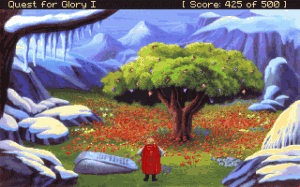 Watch the 2006 TED talk by David Perry shown below, and ask yourself if you’ve ever been emotionally impacted by a video game. For me, the answer is clear. I still reflect fondly on the hours upon hours I spent playing and replaying my old adventure and otherwise plot-driven games like King’s Quest, Quest for Glory, Indiana Jones and the Fate of Atlantis, Wing Commander, and others. I’ve always had an affinity for this type of game, where storylines drive the player to work their way through complex situations. Once the problems in the game are solved, the player emerges with very real feelings of satisfaction and accomplishment, knowing they have affected the progression of the story in some way, even if behind the scenes the game’s direction is more linear than open-ended. Often these stories convey very meaningful, thought-provoking, and emotion-evoking situations. I remember shedding a few tears at the end of Grim Fandango, and getting lost in the immersive worlds of Final Fantasy. As Perry says in his talk, a well-designed game will “seamlessly weave the user in the fabric of the virtual experience,” and that exactly what games have done for me.
Watch the 2006 TED talk by David Perry shown below, and ask yourself if you’ve ever been emotionally impacted by a video game. For me, the answer is clear. I still reflect fondly on the hours upon hours I spent playing and replaying my old adventure and otherwise plot-driven games like King’s Quest, Quest for Glory, Indiana Jones and the Fate of Atlantis, Wing Commander, and others. I’ve always had an affinity for this type of game, where storylines drive the player to work their way through complex situations. Once the problems in the game are solved, the player emerges with very real feelings of satisfaction and accomplishment, knowing they have affected the progression of the story in some way, even if behind the scenes the game’s direction is more linear than open-ended. Often these stories convey very meaningful, thought-provoking, and emotion-evoking situations. I remember shedding a few tears at the end of Grim Fandango, and getting lost in the immersive worlds of Final Fantasy. As Perry says in his talk, a well-designed game will “seamlessly weave the user in the fabric of the virtual experience,” and that exactly what games have done for me.
This is an aspect which must drive how we design all educational games. Not necessarily to the point where students are sobbing uncontrollably while they play, but presenting them with the opportunity to totally immerse themselves in the game, and tapping into what makes games such a unique form of learning: their ability to dig deeper into our minds and emotions that traditional learning media cannot reach.
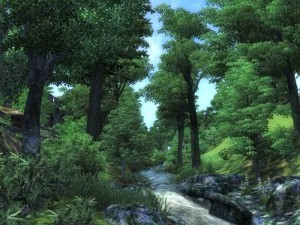 Gaming has shaped our culture, and how we see things. I identify with Michael Highland’s video shown in Perry’s talk, where he says, “When I’m driving down a road at sunset, I think this is almost as beautiful as my games are.” It’s been four years since I last played Oblivion, but every time I see a beautiful scene, such as fog covering the Wasatch Mountains, or the colorful landscape of Bryce Canyon, I instantly think, “This is just as beautiful as Oblivion.” Video games are adept at shaping and reprogramming our minds. The key is to use this for good, and use games to shape the brains of students in such a way that cannot be done with traditional media.
Gaming has shaped our culture, and how we see things. I identify with Michael Highland’s video shown in Perry’s talk, where he says, “When I’m driving down a road at sunset, I think this is almost as beautiful as my games are.” It’s been four years since I last played Oblivion, but every time I see a beautiful scene, such as fog covering the Wasatch Mountains, or the colorful landscape of Bryce Canyon, I instantly think, “This is just as beautiful as Oblivion.” Video games are adept at shaping and reprogramming our minds. The key is to use this for good, and use games to shape the brains of students in such a way that cannot be done with traditional media.
Virtual Worlds and Game-Based Learning Activities
2This past week I was wrapping up a draft of a synthesis paper about constructivist learning theory and its application to educational simulations and virtual worlds. I imagine there’s nothing new about wide-eyed educational technology students wanting an excuse to study games in school. It’s a pretty hot topic in education right now. As for me, I had a rather passive interest until our district’s IT Director approached me last year and asked some questions about how to start using virtual worlds in our district. I didn’t have an immediate answer for him. This became part of the reason I decided to enroll in Boise State’s M.ET. program.
I’ve already determined that using Second Life in our school district won’t be possible at this time, due to the adult content. There doesn’t seem to be any way for our district’s firewall to filter specific regions. We could actually customize our own Second Life viewer to whitelist a selection of regions that we’ve pre-approved, but this still won’t stop clever students from realizing they can download the standard viewer and access the inappropriate regions anyway. Teen Second Life also won’t work, since it’s intended for adolescents from 13-17 years of age, and apparently it’s rather difficult to even get Linden Lab to allow teachers on the site. Plus, none of these sites allow access for students 12 and younger, and the district never directly has any control over the actual content. The requirement for direct control is a policy we won’t be able to get around at the current time.
 For this reason, the best alternative is to host our own virtual world server. OpenSim, an open source re-engineering of Second Life, appears to be a good bet. Version 0.7 was just released a few days ago with some pretty exciting updates. The drawback to a self-hosted virtual world, however, is that our students won’t have access to the vast array of pre-built regions in Second Life that contain undeniable educational value. What this means is that we’ll need to approach our use of OpenSim from another perspective.
For this reason, the best alternative is to host our own virtual world server. OpenSim, an open source re-engineering of Second Life, appears to be a good bet. Version 0.7 was just released a few days ago with some pretty exciting updates. The drawback to a self-hosted virtual world, however, is that our students won’t have access to the vast array of pre-built regions in Second Life that contain undeniable educational value. What this means is that we’ll need to approach our use of OpenSim from another perspective.
This is where learning theories come into play. We don’t have to wildly speculate what the best practices for using a multi-user virtual environment might be. We can draw from a deep pool of theoretical frameworks to make informed, educated decisions about how to create the most effective, engaging, motivating learning opportunities. Our young students do seem to be particularly fond of online gaming in general. Massive multiplayer online games (MMOGs) have increasingly become the dominant form of entertainment for children and adolescents (Paraskeva, Mysirlaki, & Papagianni, 2010).
It seems natural that a self-hosted virtual environment which has in-game modeling and scripting tools would naturally be an ideal playground for allowing students to become creators. Constructivist learning theories are a good fit, as they place the focus on learners, and cast them in active roles responsible for their own knowledge construction. Students can generate shareable artifacts in the virtual world. The teacher supports students’ learning, rather than dictates the information to them, and in the case of a virtual world, this would be accomplished by setting up virtual learning environments in which students can discover aspects the teacher wishes them to learn, and probably a few things they don’t expect, and allocating different tasks to students as they explore, test their theories to solve the tasks, and reflect on their learning.
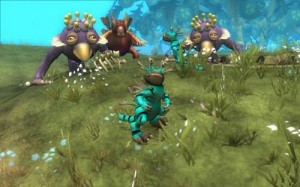 In the game Spore by Electronic Arts/Maxis, for example, players guide the evolution of a species from a single-celled organism to fully sentient, intelligent, communicative beings that colonize the galaxy. Unlike scientific evolution, in which species are primarily the products of adaptive change, players have control over the appearance and many of the evolutionary characteristics of their creatures. Teachers could have their students form hypotheses about advantageous creature traits, and test them in the game world by building the creature accordingly through a simulated, albeit simplified evolutionary process. Through the process of discovery, students can learn:
In the game Spore by Electronic Arts/Maxis, for example, players guide the evolution of a species from a single-celled organism to fully sentient, intelligent, communicative beings that colonize the galaxy. Unlike scientific evolution, in which species are primarily the products of adaptive change, players have control over the appearance and many of the evolutionary characteristics of their creatures. Teachers could have their students form hypotheses about advantageous creature traits, and test them in the game world by building the creature accordingly through a simulated, albeit simplified evolutionary process. Through the process of discovery, students can learn:
- Basic principles of evolution as they advance through the different stages of the game
- Microbiology as they explore the primordial sea as a microorganism propelled by its flagella
- Zoology when they have to choose through their actions whether their creature is an herbivore, carnivore, or omnivore (this affects the primary cultural characteristics of the species later in the game)
- Astronomy as they explore other solar systems
- Politics when they encounter rival civilizations and are forced to coexist.
When things don’t go as planned, the students reform their hypotheses and test again. Part of this constructivist-based problem-solving model includes periods of reflection. It’s important that students, since they are their own knowledge constructors, have a chance to adequately reflect on what they are learning, and make the proper connections.
It’s almost inevitable that games not designed specifically for curricular learning will introduce inaccuracies, since there’s often a trade-off between entertainment value and realism. However, these points of inaccuracy can be teaching moments as well. For instance, asking “How is the evolution portrayed in Spore different from scientific evolution?” could prompt a great discussion in class. Spore is a rather fun tool for hypothesizing and fantasizing about how intelligent space-faring species might evolve, since as of now, humans are the only point of reference. But ultimately this demonstrates the advantage a fully-controllable virtual world provides, where you can design the simulation from the ground up so it follows particular curriculum standards and objectives, rather than having to mold a preexisting game around the curriculum.
I’m already considering the changes I’ll make to my paper for the final draft. It’s been nice to be able to draw on my past video game experience (and my parents thought I was just wasting time by playing them!) and adjust my perspectives with a new outlook.
References
Paraskeva, F., Mysirlaki, S., & Papagianni, A. (2010). Multiplayer online games as educational tools: Facing new challenges in learning. Computers & Education, 54(2), 498-505.

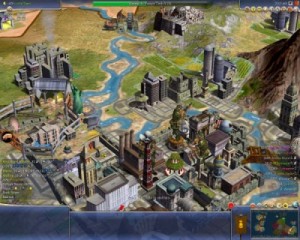 Gaming is an activity enjoyed by many students, and when used for educational purposes, games can improve student motivation towards learning, particularly when used in the creation of constructivist learning opportunities. Applying constructivist principles to educational game-based learning activities yields an approach that puts students in the role of active learners and content creators.
Gaming is an activity enjoyed by many students, and when used for educational purposes, games can improve student motivation towards learning, particularly when used in the creation of constructivist learning opportunities. Applying constructivist principles to educational game-based learning activities yields an approach that puts students in the role of active learners and content creators.